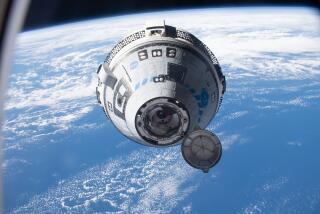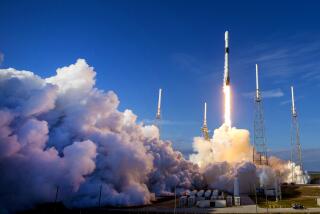Virgin Galactic: ‘Single human error’ led to catastrophic crash, NTSB says
- Share via
Pilot error — and a lack of safeguards in place to prevent it — was the main cause of the deadly crash of Virgin Galactic’s SpaceShipTwo in a test flight last fall, federal safety officials said Tuesday.
The crash killed the copilot, Michael Alsbury, and injured the pilot, Peter Siebold, who survived despite being thrown from the disintegrating aircraft 10 miles above the Mojave Desert.
SpaceShipTwo broke apart Oct. 31 seconds after separating from its carrier aircraft and firing its rocket engines because Alsbury prematurely unlocked the plane’s “feather system,” or movable tail, the National Transportation Safety Board concluded during a hearing in Washington.
The NTSB faulted the plane’s builder, Scaled Composites, and a lax Federal Aviation Administration for failing to head off the possibility that human error could lead to catastrophe. It called for more aggressive federal oversight and stronger industry safety standards.
Virgin Galactic, billionaire Richard Branson’s proposed ferry for taking wealthy tourists to the edge of space, said it had fixed the feather-unlocking problem cited by the NTSB and would press on with its program.
Virgin Galactic says it has 700 customers from more than 50 countries who have bought a ticket for as much as $250,000 to fly on SpaceShipTwo. The firm, with space tourism competitors such as XCOR Aerospace in Mojave and Space Adventures in Virginia, hasn’t said publicly when it hopes to begin service.
“Although we will never forget the tragic loss of Michael Alsbury, with the investigation completed, Virgin Galactic can now focus fully on a strengthened resolve to achieve our goals,” Branson said in a statement.
Some of Virgin Galactic’s customers said they too were undeterred by the findings.
“I have no thought about turning in my ticket,” said Bob Kulick, a co-owner of the Cici’s Pizza chain in Texas.
“Obviously it was a tragedy for the program and especially for the pilot that was killed,” Kulick said. But he added, “This is the culmination of a lifelong dream and I think there’s a lot of people who are the same way.”
Still, the NTSB findings are likely to raise new safety expectations for the nascent commercial space industry, requiring some of the routine cockpit technology found in jetliners to prevent pilot error from causing a catastrophic accident.
And such standards probably will increase the complexity, weight and cost of future spacecraft. All of those trends will weigh on the future success of what visionaries hope will become a robust industry of ferrying space tourists first to the edge of space and eventually into orbiting luxury space hotels.
“You always want to make your systems less expensive, but that is going to be a challenge in commercial space,” said Marco Caceres, an aerospace analyst with Teal Group. “Making them safe but not prohibitively expensive is a trade-off.”
The Virgin Galactic aircraft is designed to blast to the edge of Earth’s atmosphere, about 60 miles high, then gradually descend, slowed by the feather system.
The feathers look like long tails of a regular plane on the way up, then fold up and create aerodynamic drag to slow the aircraft on the way down.
The board placed most of the blame on Scaled Composites, a Mojave-based unit of defense giant Northrop Grumman Corp. that designed and built SpaceShipTwo and employed the two pilots.
“The probable cause of this accident was Scaled Composites’ failure to consider and protect against the possibility that a single human error could result in a catastrophic hazard” to the aircraft, the NTSB said.
“This failure set the stage for the copilot’s premature unlocking of the feather system as a result of time pressure and vibration and loads that he had not recently experienced,” the board said.
It remained unclear why Alsbury unlocked the feather system before the plane reached the required speed of Mach 1.4. Investigators previously had revealed that video taken from inside the cockpit showed Alsbury unlocking the system too soon.
The Virgin Galactic spacecraft began on the drawing board of aerospace genius Burt Rutan, who had a stick-and-rudder approach to flying the craft. It put the hands of pilots, rather than computers or automated systems, on the direct controls of the craft.
The NTSB questioned whether the aircraft system should have allowed Alsbury to make such an error. Jetliners have largely automated such pilot error out of their systems.
The safety board faulted the FAA for failing to recognize that Scaled Composites’ hazard analysis had not adequately considered the possibility of human error.
The FAA, the board said, had been under pressure to approve the SpaceShipTwo flight within its 120-day period for weighing such applications and had lacked communication with Scaled’s staff.
The safety board recommended several steps to remedy those lapses.
“The FAA takes all NTSB recommendations seriously and we will formally respond in 90 days,” FAA spokesman Hank Price said.
Scaled Composites said in response to the NTSB’s findings that “safety has always been a critical component of Scaled’s culture” and that the firm had “already made changes in the wake of the accident to further enhance safety.”
After the accident Virgin Galactic took over the design and building of a new version of SpaceShipTwo. Virgin Galactic said its engineers “have designed a mechanism to prevent the feather [system] from being unlocked at the wrong time in future flights.”
Critics of the industry say it has tried to move too quickly, seeking to accelerate the start of passenger flights before all the kinks have been worked out.
Thomas Anthony, director of USC’s Aviation Safety and Security Program, compares the problems facing the space industry to motorcycles. Owners know that motorcycles are less safe than cars but still expect the brakes to work and the engines not to catch fire.
“We can expect more safety regulations on the industry,” Anthony said. “Safety is always a balancing act, even with commercial aviation.”
But another would-be passenger on Virgin Galactic’s list, Las Vegas-based real estate investor Ken Baxter, said he still has “100% confidence” in the program’s engineers and pilots.
“I have no doubt in my mind that they will pull this off,” Baxter said. “I’m going to outer space.”
Times staff writers Christine Mai-Duc and Melody Petersen contributed to this report.
More to Read
Inside the business of entertainment
The Wide Shot brings you news, analysis and insights on everything from streaming wars to production — and what it all means for the future.
You may occasionally receive promotional content from the Los Angeles Times.












